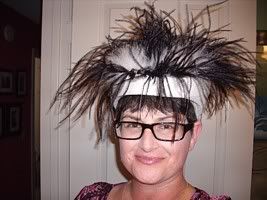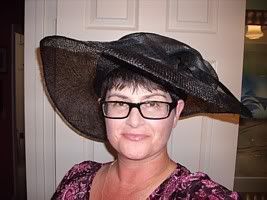We finally arrived on Iona, after a harrowing trip down a one-lane road out in the middle of nowhere. We stayed at the St. Columba Hotel, which was a very small hotel on an island devoted to the religious retreat, so it had tiny little rooms. OTOH, there was lots of hot water and interesting soaps, the food was amazingly good (many of the vegetables came from the hotel's organic garden), and the views from the hotel common room were just outstanding.
And I had my own room. wOOt! No more motorboat full of bears. :-D
The only downside to being in Scotland was that it was cold as kraut. If it was this cold and rainy in the height of summer, I have to wonder what winter is like. It's no wonder the Scots were so cranky and contentious. They were cold and wet, all the dang time. ;-)
Our first full day on Iona, we took a walk to the abbey in the morning, then had prayers with the community. After that, we did more walking around the island, more prayers, then tea with at Bishop's House that night.
The daytrippers were much in evidence on the island. In fact, Iona wais so crowded with tourists during the day that it was hard for me to find a place to just sit and be quiet and listen for the voice of God. I could have struck off for the hills, but I didn't have a map or any idea of where I was going, so I was hesitant to wander off, even though it is a very small island.
Several of us took a nice boat trip one morning, while the rest of the group hiked to Columba's Bay. The water in the Iona Sound and surrounding ocean was the most beautiful color of blue (on the rare occasions when the sun shone), and we saw harbor seals, all manner of birds, Columba's Bay (we sailed around the island just in time to see our group come hiking over the hill), and Balfour Bay, which was the inspiration for Robert Louis Stevenson's book, "Kidnapped". And no wonder. It was absolutely stunning, with white sandy beaches, blue/green water, and steep stone cliffs. Our captain, Mark, anchored in the bay and made us cups of hot tea, while we talked nature and U.S. politics.
And just to show that pride goeth before a fall, I was so proud of myself for packing light and for bringing old things that I could throw away as I wore them to make room for my souvenirs. Alas, it turns out that Scotland was so wet and cold that I steadily bought clothes the whole time I was here. I purchased a boiled wool hat at Argyll Castle, two pairs of socks in Inverary, and a wool hat, wool gloves, a fleece jacket, and a wool sweater in Iona. And I wore every bit of it.
The next day, we spent time on both Iona and Mull. It warmed up a bit, and the sun was out almost all day, which turned the water around the island all kinds of beautiful, jewel-like colors. We visited Torosay Castle, where a charming older woman by the name of Jaquetta Digby James, wife of a British war hero and sister to the former U.S. Ambassador to France, gave us a private tour of the house and gardens, and Duarte Castle, where Lachlan MacLean, 28th Chief of the Clan MacLean, gave us a personal tour of the keep.
It had been a wonderful trip, up to this point, but I was still looking for the thin places that Iona is famous for. I expected Iona to be the spiritual highlight of the trip, and it hadn't been. Cumbrae, the Cathedral of the Isles, and the modified monastic rhythm that we experienced there were much more spiritually satisfying. Iona seemed just so, well, touristy. People come to Iona to say they've been there and nothing more. Plus, we weren't really part of the community. We were merely curious outsiders, looking in. It didn't help that we seemed to be going ninety miles a minute to be tourists ourselves, and I felt like I was losing what we had on Cumbrae as a community of Christ. No one else seemed to be as bothered by it as I was, so I decided that I would strike off on my own again after we got back from Staffa the next to see if I could find what I was missing on this leg of the journey.
The next day, we took a boat to Staffa (inspiration for Mendohlson's Symphony for the Western Hebrides), and it was an unmitigated disaster. Well, maybe not unmitigated, but I made a big baby of myself. I didn't realize that you had to climb to the top of the island on an aluminum staircase bolted onto the side of a cliff to get up to where the puffins are. As you may or may not know, I'm terrified of high, open places, and I have terrible vertigo. But I was determined to get to the top, because we were going to have a reconfirmation of our baptismal vows up there and then see the puffins. Unfortunately, the climb was so terrifying that, by the time I got to the top of the stairs, I was sobbing like a small child, and I continued to cry quietly through the whole reconfirmation liturgy. I tried to stop, but I just couldn't. The thought that I would have to go back down those same stairs facing out over the drop to the ocean wasn't helping me to gain my equilibrium. I did manage to calm down before starting off to the other end of the island to see the puffins, but I had to detour from some places on the path, because they passed too closely to the edge of the cliffs.
Surprisingly, the trip back down the stairs wasn't as terrifying as the trip up. I crouched low, gripped the rails, and kept my eyes focused on the rock face, and I managed to make it down without a resurgence of tears. Several people offered to help me down, but that would have just made it worse. I tend to panic a little, when someone touches me while I'm on a high place, because I'm so afraid of falling.
Anyway, the puffins were adorable, the island was beautiful, and we saw some huge dolphins on the way. It started to rain on the way back from Staffa, so I was pleased that I had my poisonous yellow rain poncho with me. Others were not so lucky.
Next Up: More Iona, and God finally says 'hey'.






